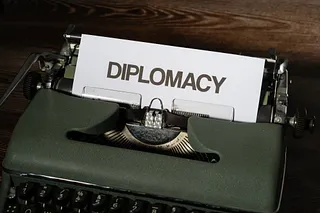ET as Diplomacy
Here’s a riddle for you: What’s hard to identify, hard to develop, and hard to maintain? If you answered “international...

Here’s a riddle for you: What’s hard to identify, hard to develop, and hard to maintain? If you answered “international partnerships” congratulations! You get to move on to the next round.
Now, the tough question. How do you approach a country with whom you do not historically have great relations and create a path toward better partnerships? Ok, if you know the answer to this one definitively, stop reading right now and open your favorite ridesharing app. Type in the following address and tell the first person you see that you’ve solved international relations and you need to see the person in the Oval Office:
1600 Pennsylvania Avenue, Washington DC
If you aren’t completely sure, you aren’t alone. The simple if obvious truth about international partnerships is that it is easy to have partnerships with partners. Once you are partners, you can cooperate, trade, do military drills together, all the fun things. But when you have cold relations with a country, it’s hard to know where to start.
For the last twenty years, the US had a pretty good answer to the round two question. We used counterterrorism. This is what you’d call a “compatible issue” meaning an issue that we could take to just about any country and offer some assistance on counterterrorism issues. It was good for us, it was good for them, and it was bad for terrorists. Good all around. With few exceptions, countries around the world could pretty much agree that they did not want terrorism, so this was where we started. Once we established that counterterrorism cooperation was good, we could expand and cooperate on other things. Maybe we dangled some other exciting things like preferred trade status or the visa waiver program and before you could say soft power, we had ourselves a new friend. But the world changes and so does our approach to finding compatible issues on which we can work with international partners. Terrorism is certainly not dead, but it would be hard to argue that it has the reach that it once did over the past 20 years. Without that reach it also does not have the compatible issue sexiness that attracted so many international suitors. Interestingly, the US is already on to what the next attractive suitor issue will be, but it needs to lean in and get more serious. Emerging technology is the usurper of counterterrorism as a focus area for enticing international partners. The US recognizes this and is using the topic on a small scale but must create a consolidated diplomatic effort behind emerging technologies or risk ceding ground to China.
In December of 2021, the Biden Administration released its Space Priorities Framework. In it, the Administration calls for space to be used as diplomacy. This isn’t particularly groundbreaking as space has been used diplomatically since the Cold War. But that's not all. In perhaps the clearest signal that emerging tech is being used as diplomacy, the US signed the Initiative on Critical and Emerging Technologies with India in January of 2023. It would be difficult to imagine a country the US would want to add to the friend column more than India and the big guns we pulled out for them was an agreement on emerging tech cooperation. Finally, the Biden Administration released its National Standards Strategy for Critical and Emerging Technology in May of 2023. The strategy focuses on US participation in international technology standards making processes. These policy documents represent a clear if disjointed effort to bring wield emerging technology as the newest internationally compatible issue to entice cooperation.
Especially now, who wouldn’t want to find ways to advance their artificial intelligence or to increase their telecommunications capabilities? Advancements in STEM fields and in research and development are difficult to argue with. New economic opportunities, improved STEM education, new statecraft capabilities. What’s not to like? But if we are being really honest with each other, the US is awfully late to the game. China was hip to this change in 2013 when the Chinese government adopted the Belt and Road Initiative strategy. There are plenty of reasons to criticize China’s execution of its version of emerging technology diplomacy, but it’s also hard to argue that it hasn’t had results. China’s influence and economic sphere have expanded considerably because they offered something that the US was still years away from offering; technology-based assistance in exchange for what they would call partnership. The US has spent billions of dollars countering Belt and Road Initiative projects around the world and trying to find ways to spin allies off from China and bring them into the US orbit, like India. We are starting to wake up to using emerging technology as diplomacy, but it is currently piecemeal and lacks a unifying vision.
The good news is that the US has the pieces in place. There’s a solid policy foundation to create the runway and momentum for a broader diplomatic effort around emerging technology. What’s lacking is a clear and unified approach that prioritizes the emerging technology issue as not only a major diplomatic carrot but also as the defining strategic asset in great power competition. The other piece of good news is that while China may have actioned the issue first, their approach is widely recognized as toxic and predatory. This leaves the door open for the US to compete directly with China diplomatically when the odds are in our favor. To capitalize on a strategic error in execution by China, the US should double down immediately on the momentum behind technologies like AI, quantum, and outer space. This prioritization should form the backbone of the State Department’s diplomatic efforts with key partners and should extend to areas like military-military cooperation, law enforcement partnerships, trade relationships, visa requirements, and more. Unifying direction from the White House in the form of a Technology and National Security Strategy should be created and signed giving all executive branch departments and agencies the guidance they need to use this issue to the strategic advantage of the US. Specifically, the following issues should be central components of the strategy:
Post-Quantum Cryptography: The US has done an excellent job laying down policies and laws to cover leadership in quantum and response to the threat to encryption. The response to the threat is a true global issue and will require a consolidated and unified international effort to ensure security. Partnering on quantum policies and transition to the new algorithms is an obvious international partnership effort.
Space: Space has been a compatible issue for decades, but the US must get more active. The National Space Council should continue to look at ways to enable and enhance the commercial space industry and conduct more outreach to likeminded spacefaring nations. While this issue is prioritized in the Space Priorities Framework, execution against it has been underwhelming.
AI: AI conversations can quickly get wrapped around privacy conversations given data use. The US and EU have not found a lot of common ground following the EU AI Act and the GDPR. But there is common ground to be found in areas like AI governance or risk. There are also productive conversations around how AI can enhance government missions and create economic value that would place the discussions on more positive footing.
Connected Communities: The convergence of technologies will be far more interesting than any individual technology and how convergence impacts urban environments will be a significant national security and socio-economic issue ripe for cooperation.
The first step toward taking advantage of an inherent American strength (technology innovation) combined with a strategic error on the part of China (BRI) is to bring the various arms of US national power into alignment. Next, the goal is to find specific compatible issues that we can bring to potential partners that will show success and allow us to build more cooperation. There are no sweeter carrots right now than emerging technologies. Just like we could almost all agree on wanting to eliminate terrorism, we can also agree on the desire to innovate. Beginning with a unified Technology and National Security Strategy and leveraging a small number of compatible emerging technology issues, the US can build a strong diplomatic base that will have strategic impacts on great power competition. China is not going to provide us with a steady supply of strategic errors so we must capitalize on this one. The pieces are in place, and we simply need to assemble them and use the strengths that we naturally have. We didn’t achieve first movement, but we can turn this competition into an unfair fight, advantage USA.

